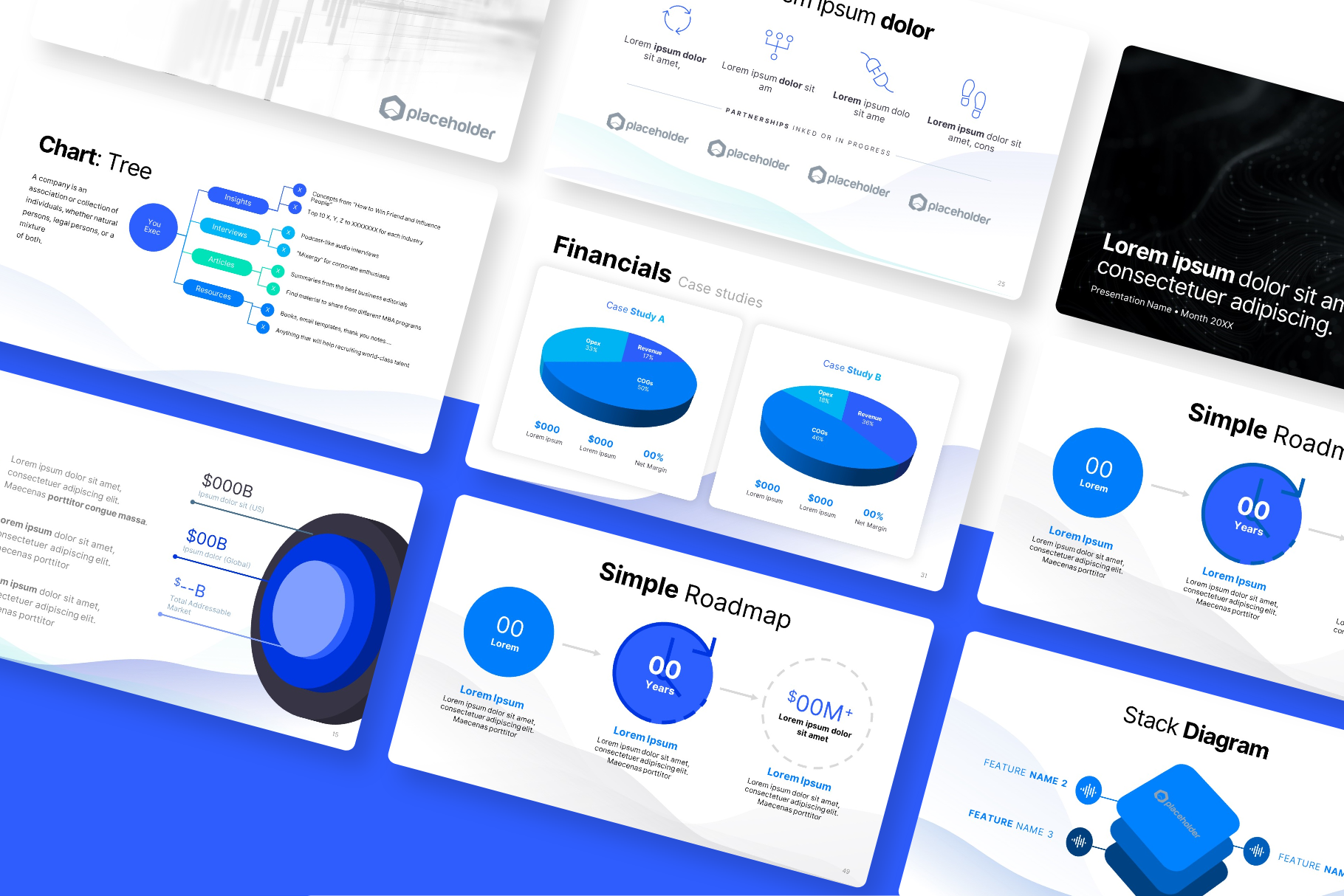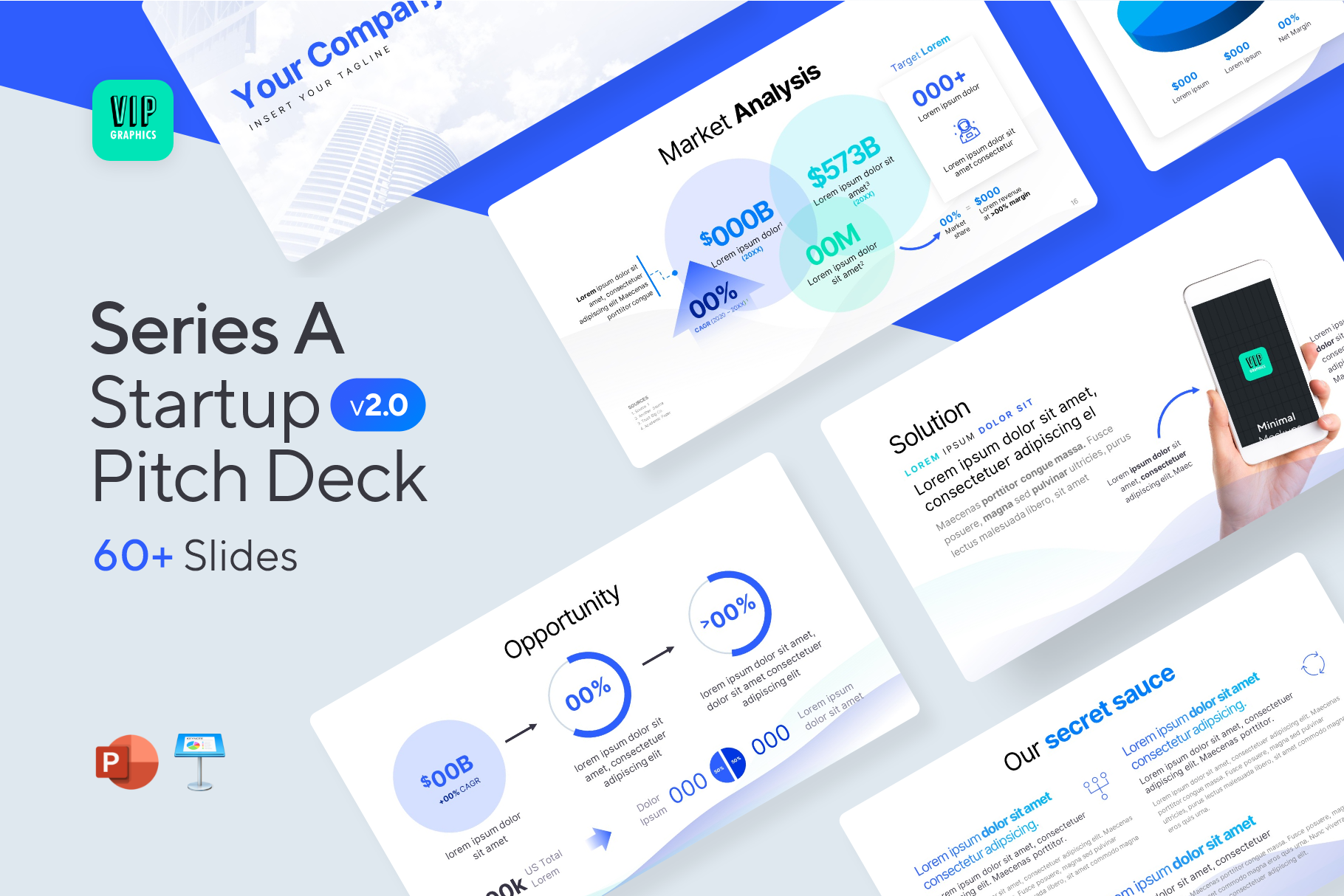Securing Series A funding is a critical milestone for early-stage startups on their path from concept/idea to MVP to a scalable, profitable business model. Whereas pre-seed and seed rounds typically fund the development of the minimum viable product (MVP) and initial go-to-market (GTM), Series A funding typically comes after a startup has achieved product-market fit (PMF) — though there are some notable exceptions, like Mistral AI’s €105m pre-product raise.
Raising Series A funding is challenging for even the best founders: only about 1 in 3 seed-stage startups will successfully raise Series A funding. With a sea of hopeful entrepreneurs vying for investor attention, how do you make your pitch stand out? Here, we’ll discuss how to craft the perfect Series A pitch deck that highlights your achievements, outlines your vision, and convinces investors of your startup’s potential for scalable success.
What is a Series A pitch deck? What is its purpose?
A Series A pitch deck is your investor presentation designed to secure institutional capital for your startup. An effective Series A pitch deck should demonstrate that you have achieved product-market fit, validated demand for your offerings, and have a plan to tap into a multi-billion-dollar market opportunity. It’s your opportunity to showcase your team, market, product, traction, and financial projections in a compelling and concise pitch.
Securing Series A funding can be a daunting challenge: according to Dealroom, only about 20-30% of seed-stage startups successfully raise a Series A. This means you’re up against stiff competition. Your pitch deck is your golden ticket to stand out from the crowd.
How is a Series A pitch deck different from a seed pitch deck?
Series A funding differs significantly from earlier stages. Unlike seed capital, which often comes from personal networks, Series A investments typically originate from institutional investors seeking high-growth opportunities.
For most startups, Series A funding is also the first “institutional capital” into the company, meaning that the round is typically led by a VC firm or other institutional investor, whereas earlier rounds are often from angel investors, accelerator programs, &/or friends and family. Most Series A rounds are also the first “priced round” for startups (meaning the terms of the round specify a pre and post-money valuation for the startup), whereas seed rounds are usually structured as convertible or SAFE notes that use a “valuation cap” and discount on future rounds, instead of stating a valuation.
Whereas seed and pre-seed pitch decks focus on vision and product, Series A decks spend more time on market validation, traction, and growth potential. An effective Series A pitch deck should provide a convincing overview of the product, target market size and demographics, revenue model, competitive advantage, and customer acquisition strategy.
What slides should be in a Series A pitch deck?
Although there are differing pitch deck recipes espoused by different investors, most decks adhere to the same general format and slide topics. That said, we’ll focus on the Series A pitch deck format recommended by Y-Combinator (the accelerator that produced unicorns like Airbnb, Dropbox, Doordash), since nearly half (45%) of YC alums successfully raise Series A funding (nearly double the industry average), according to Garry Tan:
Title Slide
Your title slide should clearly display your company’s name or logo, accompanied by a concise description that effectively communicates what your business does. This brief statement should be simple enough that anyone can easily visualize your product or service.
- Be specific: For instance, instead of saying “Revolutionizing travel,” specify with “We provide on-demand luxury car rentals,” to avoid vagueness.
- Use layman’s terms: Opt for language that’s widely understood. For example, rather than “Enhancing workplace productivity through gamification,” say “We make work more fun and engaging.”
- Focus on your unique offering: Ensure that the description clearly outlines what your business does, like “We deliver organic meal kits to your doorstep” instead of the more general “Healthy food delivery.”
Traction (Teaser)
Immediately grab investors’ attention by highlighting your most impressive achievement. This could be revenue growth, user acquisition, or a significant partnership. This slide sets the stage for the rest of your presentation, and acts as your “hook” to get investors interested in learning more.
Problem Slide
Here, you should outline the specific issue your product or service addresses. Explain how things currently operate for your customers and highlight what’s not working. Ensure the problem you describe is directly connected to what your business can solve. This slide is a precursor to your solution, so the problem needs to be clear and relatable.
- Focus on specifics: Avoid broad statements like “Mental health care is costly.” Instead, narrow it down: “Millions of Americans need therapy but can’t afford it.”
- Customer perspective: Present the problem from the viewpoint of those who pay for your product. This might differ if the end-users are not the ones making the purchase decision.
Solution Slide
After describing the problem, the next slide in your Series A deck should detail how your product or service addresses the issue. A side-by-side comparison with the current state of affairs can help illustrate the value you provide.
- Use data: Numbers can powerfully convey the impact of your solution. For example, rather than simply stating that your process is faster or more efficient, quantify it: “Our system reduces processing time from weeks to days and improves accuracy by 20%.”
- Focus on current capabilities: Emphasize what your product can do right now, rather than potential future developments.
Traction Slides (In-Depth)
The traction slide should tell a compelling story using data, showing how your business is performing and growing. Given that your Series A round will be your first priced round, you’ll want to paint a compelling case for your company being worth millions of dollars (so you don’t give up too much equity).
- Highlight key metrics: Revenue growth, customer acquisition cost, or user engagement are critical. For enterprise businesses, this might include sales cycles or contract values; for consumer businesses, metrics like customer acquisition cost (CAC) versus lifetime value (LTV) are crucial.
- Show trends: Use graphs to demonstrate trends over time, and make sure they’re easy to interpret. Present data clearly, avoiding cumulative figures that could obscure monthly or quarterly growth.
- Carefully consider how / when to showcase revenue: Some early-stage founders will opt to omit revenue in their Series A deck (esp. if it’s in the low five figures range), because it can often lower the valuation of the startup (investors tend to run discounted cash flow analyses to estimate valuation).
Market Slide
Market analysis in a Series A deck should not only demonstrate the scale of the opportunity you’re addressing, but also why now is the right time to invest. A bottom-up market size calculation using actual data from your current customer base is often the most effective approach, rather than generic industry sizing figures.
- Real numbers: Estimate the number of potential customers and the value each customer brings to your business.
- Analogies for new markets: If you’re creating a new market segment, consider comparing your business to established companies in similar spaces to help investors understand the potential.
Competition Slide
Show how your solution stands out from competitors. Focus on the unique advantages that make your product significantly better, and emphasize any barriers that protect your business from competition. Investors should walk away from this slide with a clear understanding of why customers would choose your solution over incumbents.
Vision Slide
This is your opportunity to share your long-term vision for the company. Where do you see the business heading, and how do you plan to grow it into a unicorn startup? Here’s where you can talk about distant expansion opportunities such as future product lines or verticals.
Team Slide
If your team is one of your strongest assets, you may want to introduce them early in the presentation. Many Series A decks will open with the team as the first slide, esp. if they have limited traction. Highlight your team’s experience, past successes, and any unique expertise that makes them particularly suited to drive your company’s success.
Use of Funds Slide
This slide should outline how much capital you’re seeking, what it will be used for, and what milestones you plan to achieve with that funding within the next 18-24 months.
Appendix
Most Series A decks include an appendix with additional details and extra slides that can support the Q&A session following your pitch. Prepare visual aids to address potential investor questions, financial projections, and a detailed use of funds. This section will evolve as you refine your pitch based on investor feedback.
Examples of Series A pitch decks
Understanding how successful companies have navigated their Series A rounds can provide valuable insights into what works. Here are a few notable examples:
- Nanonets: Comparing YC-alum Nanonets’ $29M Series B deck with their $10M Series A is a great place to start
- Series A: Nanonets raised $10M, laying a solid foundation for their AI-driven workflow automation platform. Their deck focused on showcasing their technology’s scalability and the growing market demand.
- Series B: With a $29M Series B, Nanonets built upon their earlier success, emphasizing their expanded customer base and enhanced product features. Comparing the two decks provides a great case study on how to evolve your pitch as your company grows.
- Yuga Labs: Yuga Labs, the creators of the Bored Ape Yacht Club (BAYC), captured significant attention with their leaked pitch deck, which played a crucial role in achieving a $4B valuation during their Series A. Their deck is a powerful example of how to leverage brand identity and community engagement in fundraising.
- Copy AI: Copy AI’s pitch deck helped them secure an $11M Series A round, backed by top-tier investors like Sequoia, Craft Ventures, and Tiger Global. Their approach focused on the massive potential of AI in content creation and how their product leads the market.
- Rippling: Rippling took a different approach by using an investor memo instead of a traditional pitch deck. This method allowed them to provide a detailed narrative, leading to a successful $45M Series A.
- NordVPN: NordVPN’s Series A pitch secured them $100M, with a focus on their strong market position in cybersecurity and future growth plans. Their deck is a prime example of how to position a company for a major funding round.
- Gusto: Gusto, known for its payroll and HR services, raised $20M in their Series A. Their pitch deck emphasized their unique approach to simplifying employee management and the vast market opportunity.
For even more inspiration and examples of Series A pitch decks, visit this collection.
Tips for designing a Series A pitch deck (bulleted list):
- Include an appendix for details: Series A decks often require a deep dive into data, so it’s crucial to include an appendix with backup slides that provide additional context and detail. This allows you to keep the main deck concise while having the necessary data on hand for investor questions. For an example of a well-crafted data deck, check out Rippling’s investor memo.
- Focus design on clarity, not beauty: The primary goal of your pitch deck should be to communicate your message clearly and effectively. Avoid overloading your slides with design elements that could distract from the content. Simple, clean layouts that emphasize key points are more impactful than visually elaborate designs.
- Practice your pitch (with angels and founders for feedback): Rehearse your pitch extensively, ideally with experienced angels and founders who can provide constructive feedback. Their insights can help you refine your delivery and ensure that your deck resonates with investors.
Ready to secure your Series A?
Streamline your preparation and ensure you cover all the crucial elements with a tried-and-tested pitch deck template. Check out the Series A Pitch Deck Template designed by our experts, and get a jumpstart on building a compelling Series A investor presentation. You can also browse our library of industry-specific pitch deck templates here!

